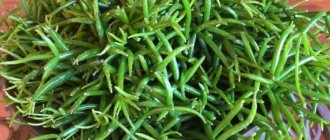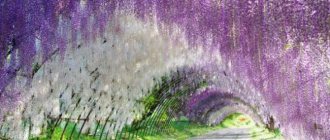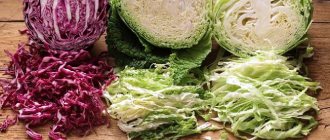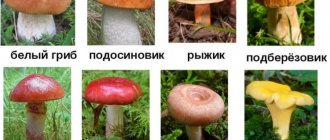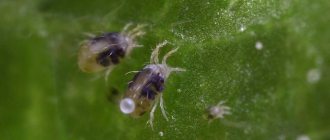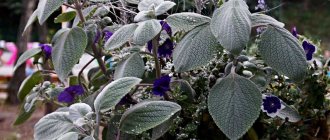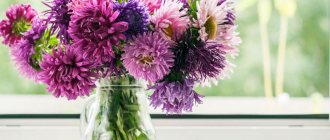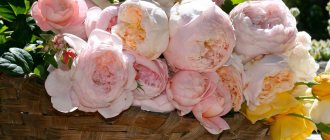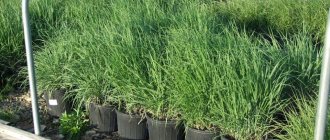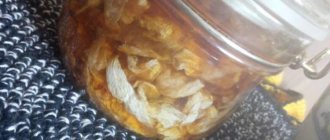Different sources cannot agree on which family the cordyline belongs to: some attribute it to the Agavovs, others insist on the Dracenovs.
In its homeland (cordilina is endemic to New Zealand, but is now found in all regions with a tropical or subtropical climate) it can reach an impressive size of about 16 meters.
It is an evergreen tree or spreading shrub with sword-shaped or linear leaves (their appearance is dictated by the variety to which the plant belongs).
When grown indoors, Cordyline, of course, will not reach such a size; 30–150 cm in height is its “ceiling”. You can see what size cordyline reaches in room conditions and in nature: the photos show the impressive difference.
Botanical description
Although exotic plants do not reach gigantic sizes at home, species are known that grow up to one and a half meters. It is an evergreen herbaceous shrub or tree-like bush .
The main difference from dracaena, with which cordyline is often confused, is the presence of a petiole and a longitudinal vein on the leaf blade.
With age, the lower leaves fall off, and it acquires an extraordinary resemblance to a palm tree. The foliage is mostly green, but there are species with pinkish and reddish colors , and there are species with spotted spots or longitudinal stripes on the leaves.
Apical or shrubby
The most common variety for home keeping. It is characterized by slow growth and a wide variety of leaf plate colors.
The apical variety has a strong trunk. Wide, elongated leaves cover the entire trunk from crown to root, but with age the lower part of the trunk loses its foliage. A panicle of leaves forms at the top of the head.
Bush cordyline grows up to 80 cm , long sword-shaped leaves give it a resemblance to a small shrub.
Varieties of Cordyline
Of the entire variety of varieties, only 15 varieties are suitable for growing indoors .
On sale there are breeding plants with a variety of colors - cordyline purple compacta, rumba, green cordyline, and small sized fruticose compacta.
Cordyline terminalis fruticosa
A very impressive plant that adapts well to apartment conditions. The leaves are quite long and wide, with pronounced longitudinal veins. The color of the leaves varies from variety to variety.
Southern Cordyline (Cordyline australis)
Suitable for large rooms or winter gardens, as it grows as a large tree with a dense trunk that widens towards the root part. The trunk is inflexible, without foliage, there is only a thick “cap” of foliage at the top.
The leaves are leathery, long, with a whitish longitudinal vein.
Interesting! In natural conditions it can reach a height of more than 10 meters.
Banks (Cordyline banksii)
This variety of plant is distinguished by a thin trunk, a beautiful panicle of long (up to 1.5 meters) leaves, green on the outside and grayish-green on the inside. The height of the bush varies from 1.5 to 3 meters.
Red (Cordyline rubra)
Unconstrained by the dimensions of an apartment, this variation of a shrub variety can grow up to 3 meters. Its foliage is painted bright red.
Undivided (Cordyline indivisa)
In nature, it grows into a huge tree. The straight trunk often exceeds 12 meters in height, without leaves, and almost does not bend. The leaves are thin, long, with a clearly defined longitudinal vein.
Straight (Cordyline stricta)
It is distinguished by a thin long trunk, even when kept indoors it can easily grow up to 3 meters, but it grows rather slowly. The leaf blades are about half a meter long, pointed, may have small notches along the edge, and have a beautiful green color. The leaves are pleasant to the touch, slightly velvety.
Fruticose (Cordyline fruticosa)
In nature, it has a deep green color and grows into an impressive tree. As a result of selection, various foliage color options were obtained, and fairly compact varieties up to 50 cm were bred.
Cordilina kiwi
It is distinguished by its small size and very impressive leaf color: they are deep green with a red border along the edge and a yellow-green longitudinal stripe.
Mix
This is not one plant, but a way of growing varieties with different colors in one pot.
Description of the plant
This is a bush with a thin trunk. 150-350 cm high. Long leaves, up to 30 cm. The upper leaves are directed upward and have a length of up to 150 cm. The leaf width is about 7 cm. The leaf is bright green on top, and its inner side is gray.
- Cordyline apex
It is also called dracaena apex. It has a long, thin trunk, which can bifurcate in the middle of the trunk. Very long leaves, up to 150 cm. The leaf itself is green, and the veins have a purple tint.
- red cordyline
This is a very tall plant up to four meters high. Dense, leathery green leaves. There are brown veins on the surface of the leaf. It reaches a length of 50 cm. The leaf width is about 5 cm. The inflorescences of this species have pale lilac flowers.
- Cordyline undivided
This is a beautiful tree, up to 12 meters tall. Strong, thin trunk. This species has large leaves. The leaf is one and a half meters long and 15 cm wide. The leaf has red veins. The leaf is green on top and bluish underneath. The inflorescences are pale white.
- Cordilina straight
The trunk is thin and flexible. The height of the tree is 3 meters. The leaves are dense, leathery with jagged edges. Bright green color. The leaf length is about 50 cm and the width is 3 cm. The inflorescences have purple flowers and grow at the top of the tree.
- South Cordilina
Tall tree, reaches 12 meters in height. At the base of the tree, the trunk is thicker. The leaves, like other species, are green in color with a light vein in the middle. The inflorescences are white with a delicate and delicate aroma.
It grows more often in the subtropics and tropics. It has a large and thick root system. The leaves have different shapes, depending on the species. It can be lanceolate, linear, urea-shaped, or with smooth or jagged edges.
The color of the leaf also varies - green with red and yellow veins, burgundy or chocolate. The flowers are beautifully colored white, red or purple. The inflorescences are about one meter long and look like panicles.
Signs and superstitions
The main question associated with a new plant is whether it can be kept at home? Will the new flower bring discord and failure?
According to Feng Shui, cordyline is a carrier of yang masculine energy, so it is better not to place the flower in the bedroom next to the bed .
It is better to place Cordilina in the office, where it will enhance creativity and performance, give strength, and increase concentration.
Important! It is best to place a pot of cordyline in the southern or eastern part of the house.
Caring for cordilina at home
Cordyline is not capricious, it takes root well and does not require special skills to grow. However, there are a number of recommendations - by following them, you can avoid major mistakes when growing .
Illumination
Cordilina does not like direct sunlight on the foliage too much - this can lead to burns, but it also does not like dull shadows.
Bright diffused light is what is required to maintain the bright color of decorative leaves and the healthy functioning of the plant.
View this post on Instagram
Posted by Marina Zavyalova (@plants_travel_green) March 22, 2020 at 10:37 PDT
Temperature
The plant is thermophilic, but there is a dormant period in winter. It is during the winter months that it is better to provide the cordiline with cooler conditions - the optimal temperature should not exceed +18 °C .
In summer you can maintain temperatures within +25 °C.
How to water
The amount of moisture required in summer and winter is different. During rest, your pet needs significantly less water than in the spring and summer.
Therefore, in the winter months it is not watered often, once a week is enough, and the soil must be allowed to dry.
In summer, water more abundantly, since the soil in the pot dries out faster, but not more than 3 times a week.
Spraying
Since cordyline naturally grows in tropical and subtropical climates, it also requires air with high humidity at home.
Particular attention should be paid to specimens with wide leaves - they evaporate moisture more actively. Spray cordilina once every 2-3 days with settled water at room temperature .
Fertilizer
Complex formulations are suitable for pets. In spring and autumn, mineral supplements are applied once a week during watering . In winter, the amount of fertilizing is reduced to 1 per month.
Growing at home
If the tree grows at home, it grows up to 150 cm and almost never blooms. Over time, some of the leaves die and the tree resembles a palm tree. The upper part of the tree has gorgeous foliage. Cordilina loves sunlight. It is better to place the cordyline in the west or east of the room.
If the plant has dark leaves, then it is better to protect it from bright sun. Air temperature 20-25 degrees. In autumn, the temperature must be reduced and in winter it can be only 5-10 degrees. This applies to subtropical plants.
For tropical species, in winter you can maintain an air temperature of 16-20 degrees . But neither species likes drafts. Moderate watering is needed; the soil should not be over-moistened. But it is also contraindicated to let the earthen coma dry out.
- Watering the plant
You can only water with water at room temperature. It is also not advisable to place it near heating devices. In summer, the plant needs to be sprayed with a spray bottle. Fertilize only from spring to autumn, then reduce watering with fertilizers. Cordyline should be fertilized once every 10 days.
Transplanting a plant
Repotting is an important part of caring for Cordyline. Small cuttings are replanted once a year. Mature plants are grown at least once every three or four years. Make sure the roots are covered with soil. Otherwise, the plant must be transplanted into a larger pot, making sure to line the bottom of the pot with a thick drainage layer.
The earth is mixed with sand and peat. Transplantation is carried out in the spring months. It is preferable to propagate the plant by cuttings. Because growing from seeds results in the loss of varietal characteristics. They do this in March. But the seeds germinate unevenly.
Some sprout in 3-4 weeks, while others can sprout in 3 months. When propagating by cuttings, it must be taken into account that 1 node must be left on the stem. You can use both the top of the tree and the stem itself without leaves for planting in the ground. But the stem must be woody.
Soil for growing
The composition of the soil is chosen as follows: sand, peat, humus (1:1:1).
Conditions for a good outcome need to be comfortable. Air temperature 20-25 degrees. Humidity should be more than 60%. Moderate hydration. If the right conditions are created, then after a month the seedlings can be planted in pots.
Transplanted using the transshipment method . There is another method of propagating Cordyline. A part of the root is separated from the rhizome of an adult tree and transplanted into a separate pot with a mixture for rooting cuttings. At the same time, cutting off all small roots.
Once the plant has taken root, it is transplanted into the ground. Cordyline has a long root system, so the pot should be high and wide. But no more than the root system, because Moisture can accumulate in empty places, which will lead to root rot. If the plant was just purchased in a store, it must be quarantined.
Planting and replanting: choosing a pot, soil composition, step-by-step instructions
After the appearance of a new flower in the house, many questions and problems immediately arise. What kind of soil, pot, support to choose, where to put it, how often to replant and how to water and feed the plant?
Transshipment of plants
For replanting Cordyline, the transfer method is optimal: it allows you to move the plant from an old pot to a new one with the least damage to the root.
Young bushes are replanted once a year in the spring . A more mature bush - older than 3 years - is replanted as needed when the old pot becomes small.
Buying a flower in a pot
When choosing a plant in a flower shop, pay attention to the condition of the flower. Cordyline should not be lethargic ; Avoid specimens with signs of disease - no spots, damage or discoloration.
Too bright colors of leaf blades with a loose stem may indicate an excessive amount of fertilizer, which will also not have a very good effect on the health of the flower.
Pay attention to the condition of the visible part of the root system. There should be no signs of mechanical damage or rotting from excessive watering .
View this post on Instagram
Posted by Roman Yuzhny (@romceg) Feb 22, 2021 at 2:51 PST
Support for false palm
For plants exceeding 1 meter in height, it is better to choose a support. Since Cordyline is not a vine and does not produce long weaving shoots, a straight vertical support is suitable for .
You can choose from a flower shop an option that is suitable in size and diameter that will support your pet.
Cordyline propagation methods
The flower can be propagated vegetatively or by seed .
Rooting cuttings
One of the common methods of vegetative propagation:
- The lignified shoot is separated from the stem and divided into cuttings so that each cutting has 2-3 internodes.
- One end of the cutting is treated with a stimulator for better root formation and buried 2 cm into the prepared substrate.
- The pot with the cuttings must be covered with film and watered regularly.
- Such a greenhouse is placed in a warm (not lower than +25 °C) place with bright, diffused light. It is recommended to ventilate the cuttings daily by slightly opening the film.
After about 30–40 days, the cutting will take root.
Rooting root suckers
For this method, the plant is removed from the pot and the root is washed. A part of the root is separated with a sterile sharp knife, and the cut areas must be sprinkled with crushed activated carbon.
Then they are planted in a selected substrate, and the improvised greenhouse is covered with film. The seedling will take root in a month .
Air layering (roots)
This propagation option will allow the formation of roots without cutting off part of the trunk and without interfering with the root system. It is considered difficult, but the safest.
To form aerial roots you will need sphagnum moss:
- A small area of bark, about 2 cm, is removed from the lignified trunk.
- The cleaned area is treated with a root formation stimulator and wrapped in damp sphagnum, covered with cellophane and fixed.
- Moss is regularly moistened.
After about a month, when roots form, you can cut off and replant the top.
Propagation by seeds
The labor-intensive method will require patience. It is important to use fresh seeds as they quickly lose their ability to germinate .
The seeds are pre-soaked, preferably using stimulants such as Zircon, and sown in a substrate of a mixture of earth and sand. The container must be covered with film to form a greenhouse. Water as the top layer of soil dries.
Attention! Seeds rarely germinate evenly.
Reproduction
The plant propagates by seeds or vegetatively. In apartment conditions, propagation by seeds is not effective , since new plants do not retain the characteristics of the mother plant.
When grown from seeds, they are sown in spring in moist soil made up of equal parts sand and peat. Seed the seeds to a depth of 1 cm. After this, the pot is covered with film. Sprouts appear after 2 weeks. Planting of seedlings into separate pots is carried out in the phase of 4 true leaves.
A simpler and more effective method of propagation is by planting basal children , which are produced abundantly under good conditions. The shoot is cut off with part of the root and, after sprinkling the wound with activated carbon, it is planted in a pot with light, fertile soil. There is no need to cover the plant.
If a shoot is accidentally broken off from a plant, you can try to root it if desired. This method should not be used as a method of planned reproduction. The broken part is cut off evenly and placed in a jar of water, which is covered with a dark film (the plant will not take root in the light).
It is optimal to add a little substance to the water that promotes root formation. As soon as the shoot forms a high-quality root, it is planted in soil suitable for the plant.
In this video, an amateur gardener shares his experience of cuttings and care:
Diseases and pests
Although Cordyline is unpretentious, due to improper care it can be affected by various diseases.
- When the trunk rots and leaves are damaged, the most common problem is overwatering and root rot. In this case, the cut top of the plant is rooted.
- If the color of the leaves turns pale , the plant does not have enough sunlight.
- The appearance of extensive light spots may indicate an excess of sunlight - the plant should be shaded.
- leaves turning yellow or are the tips drying out? The pet feels uncomfortable in a dry atmosphere.
- Very slow growth indicates depleted soil. There are two ways out - a freelance transplant with a complete replacement of the substrate or the introduction of complex fertilizing.
Cordyline pests
Main parasites:
- spider mite;
- thrips;
- scale insect;
- aphid.
It is difficult to combat pests; it is better to prevent their appearance: maintain air humidity and temperature conditions.
If parasites appear, it is recommended to wash the cordyline foliage with a soapy solution, treat the bush with an insecticide and remove the top layer of soil .
Beautiful foliage, ease of care, variety of species - all this makes Cordyline a favorite of gardeners. It will decorate any room, be it a living room in a house or a reception area in an office.
Diseases and pests of cordyline (table)
| How does it manifest? | Who is harming? | How to help and prevent it? |
| The leaves are covered with small light spots on top, and after a while they acquire shine, then fade. | Thrips have settled on the underside of the leaf. | Remove leaves affected by the pest. Treat the plant with a systemic insecticide (Decis, Actellik, Intavir). Carry out water treatments more often. |
| Young shoots and leaves curl and dry out, and tiny insects are visible. | Aphid attack. | Treat the plant with specialized aphid repellents (Antitlin, Biotlin) and preparations containing permethrin. |
| Brown or yellow hard spots appear on the bottom of the leaves. | Defeat by scale insects. | Use a napkin or sponge to remove insects; they hide under shield spots. Treat the plant with Aktara or Confidor. For prevention, it is useful to apply a foam of laundry soap to Cordyline and leave for an hour. Afterwards, rinse off with a warm shower. |
| There are white fluffy lumps on the leaves and stems, under which the pest is hidden. The leaves become sticky, turn yellow and die. | Mealybug. | Destroy the parasites manually, treat the plant with Aktara, Confidor or Fitoverm. Repeat after a week. |
| The leaves droop, wither, but do not dry out. The shoots lose their elasticity and die. | Root damage caused by fungus. | Remove the plant from the soil, remove damage, treat the roots with a fungicide and activated carbon. Then plant in new soil. If the roots are completely dead, cut off and root the top. Prevention: plant the plant in a sterilized substrate, do not allow the soil to become waterlogged and the roots to overcool. |
